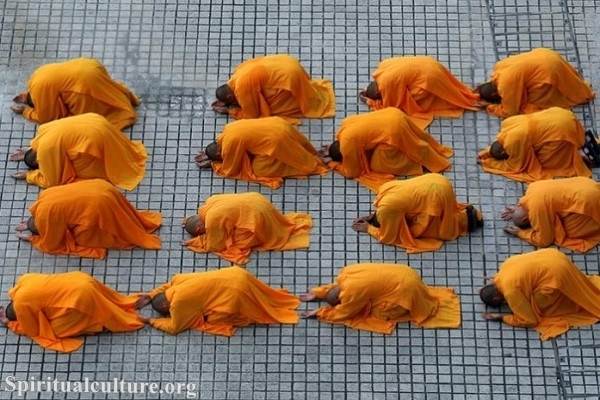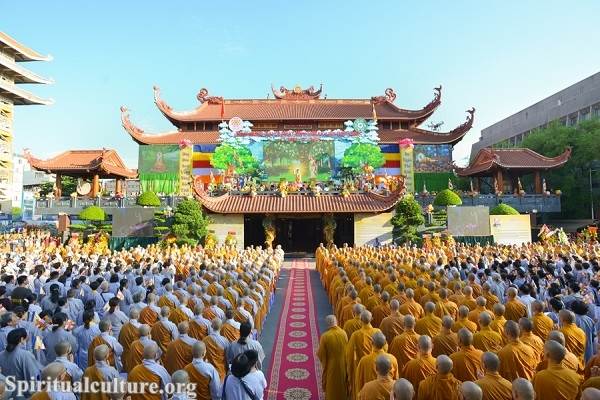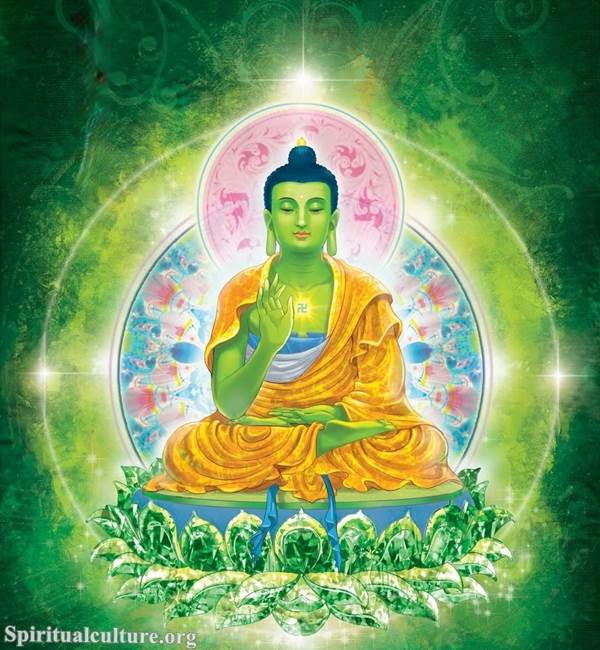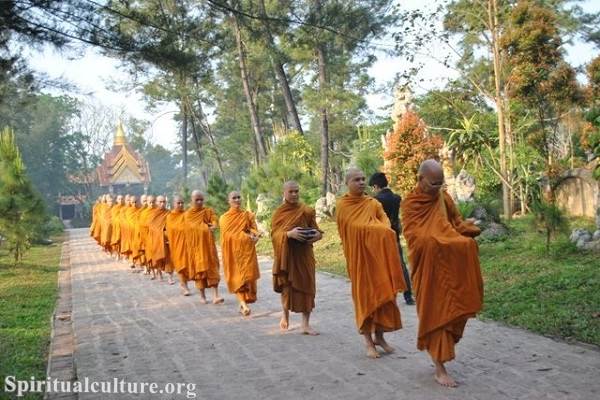Time is more than just a ticking clock or a linear path from birth to death. In Buddhism, time is intimately connected with the nature of suffering, impermanence, and liberation. How we perceive time — as fleeting moments, recurring cycles, or timeless truth — shapes our very approach to spiritual awakening.
Both Theravāda and Mahāyāna traditions, while rooted in the same teachings of the Buddha, offer distinct and profound perspectives on the nature of time. These perspectives reflect their broader worldviews — one more analytical and psychological, the other more visionary and metaphysical.
In this article, Spiritual Culture invites you into a contemplative journey through time as viewed by these two great streams of Buddhism. You will discover how each tradition helps us not only understand time, but rise above it.
Time as Saṃsāra: The Cycle of Birth and Death
Both Theravāda and Mahāyāna Buddhism regard time not as linear progression, but as a recurring cycle known as saṃsāra. This cycle of birth, death, and rebirth underpins all existence, governed by karma and conditioned by ignorance and craving. The Buddha taught that this cycle is beginningless, highlighting its profound entrapment. In Saṃyutta Nikāya (SN 15.1), he declared, “Long is the cycle of birth and death… A beginning point is not discerned.”
In Theravāda Buddhism, saṃsāra is a burden to be escaped through wisdom and discipline. Time continues so long as ignorance remains. Karma, seen as moral causation, plays out through time, with every action planting seeds that ripen in this life or the next. The ultimate goal is Nibbāna, which lies beyond the temporal stream. Each moment is viewed as an opportunity to break the cycle, emphasizing present-moment awareness as a path to liberation.
In contrast, Mahāyāna Buddhism embraces a broader, more compassionate vision. While the cyclical nature of saṃsāra remains, Bodhisattvas willingly remain within it to assist others. Time becomes the setting for compassionate action. In the Lotus Sūtra, the Buddha reveals his apparent passing into Nirvāṇa as an expedient means. This suggests that even saṃsāra and Nirvāṇa are not truly separate, pointing toward the Mahāyāna theme of emptiness (śuṇyatā) and non-duality.
Impermanence and the Moment: Time as a Stream
A foundational Buddhist insight is anicca, or impermanence. Everything that arises will pass away, and this includes the very flow of time. Theravāda Buddhism takes this insight to a microscopic level. Through the Abhidhamma, it describes existence in terms of khaṇas — brief, discrete moments in which phenomena arise and vanish. This analytical approach sees time as a stream of momentary events, with no enduring essence. Meditation practices like vipassanā train the practitioner to witness this process directly, leading to profound insight into the transient nature of all things.
Mahāyāna, particularly in schools like Madhyamaka and Yogācāra, often views time as a mental construction. Rather than focusing on discrete temporal moments, these schools emphasize that the past, present, and future are conceptual projections. In ultimate reality, time has no inherent existence. The Avataṃsaka Sūtra famously presents a vision where time and space are infinitely interpenetrating, each moment containing all others. This vision encourages meditators to step beyond conceptual limitations and experience the timeless suchness (“tathatā”) of reality.
Liberation and Timelessness: Nibbāna and Buddhahood
For Theravāda Buddhists, the goal of practice is to transcend time by realizing Nibbāna. Nibbāna is described as unconditioned (āsaṃkhata), and beyond the cycles of becoming. In the Udāna (8.3), the Buddha states, “There is, monks, an unborn, unbecome, unmade, unconditioned… were it not, there would be no escape from the born, become, made, and conditioned.” This suggests that Nibbāna is not just beyond suffering, but beyond time itself. Attaining it is akin to stepping out of the stream entirely.
In Mahāyāna, particularly in texts like the Lotus Sūtra, the Buddha reveals his true nature as eternal. The concept of Dharmakāya (the truth body) implies that the Buddha is a timeless presence that manifests across countless eons to guide beings. In this view, time is not merely escaped but redeemed. Compassion persists across all time, and enlightenment includes embracing this boundless view. The Bodhisattva ideal embodies this commitment to act within time for the sake of others, while knowing its ultimate emptiness.
Meditating on Time: Practices of Presence and Insight
Meditation is the key method through which Buddhists experience the nature of time. In Theravāda practice, the Satipaṭṭhāna Sutta lays the foundation for mindfulness rooted in the present moment. By observing the breath, bodily sensations, mental states, and phenomena, practitioners anchor their awareness in what is immediately arising and ceasing. This focused presence reduces attachment to past regrets and future anxieties. As clarity deepens, the practitioner sees that time is not a solid entity but a sequence of impermanent moments.
Mahāyāna meditation, especially in traditions like Zen or Dzogchen, often encourages direct insight into timeless awareness. The instruction may be to “just sit” or abide in “rigpa,” an open presence beyond conceptual grasping. These practices are less analytical and more experiential, inviting the meditator to rest in a natural state where time is seen as fluid, even illusory. The Heart Sūtra encapsulates this realization: “Form is emptiness, emptiness is form… past, present, future — no different.”
Cultural and Philosophical Implications
Cultural expressions of these teachings reflect the distinctive emphases of each tradition. In Theravāda societies such as Thailand, Sri Lanka, and Myanmar, time is often seen in terms of moral urgency. Life is short, and the opportunity for good karma is precious. Merit-making activities, monastic support, and disciplined meditation are all encouraged as ways to use time wisely and escape the cycle.
In Mahāyāna cultures like Tibet, China, and Japan, time expands to encompass vast cosmic ages. Multiple Buddhas, celestial realms, and the vows of Bodhisattvas create a vision where time is not just a resource but a canvas for awakening. Practices such as chanting the name of Amitābha Buddha link the practitioner to timeless realms, suggesting that spiritual time is participatory and grace-filled.
Bridging the Traditions: Time as Compassion and Wisdom
Despite their differences, both Theravāda and Mahāyāna Buddhism converge in a powerful insight: time is not ultimate. It is a conditioned reality that can be transcended through wisdom and compassion. Theravāda offers tools for insight into impermanence and the cessation of becoming. Mahāyāna offers a vision of compassion that spans eons, inviting practitioners to serve within the illusion while realizing its emptiness.
Buddhism does not seek to destroy time, but to liberate us from its tyranny. It teaches that our suffering is often bound up with clinging to the past or fearing the future. By entering the present fully, and seeing through time’s constructed nature, we begin to touch the eternal.
Reflect and Reimagine
In a world obsessed with schedules, deadlines, and future projections, the Buddhist vision of time offers something radically freeing. Time is not our enemy, nor our master. It is a mirror — reflecting the mind. It is a teacher — revealing impermanence. It is a bridge — leading us home.
Whether you follow the Theravāda path of sharp insight or the Mahāyāna path of boundless compassion, the invitation is the same:
Wake up now. This moment contains eternity.
Let go of clinging to time — and discover the timeless.
Spiritual Culture invites you to pause, breathe, and ask:
What is truly timeless in your life?
What would it mean to live as though this moment is sacred?
Let the wheel turn — or step off it.
Either way, awareness is the key.





